Although there are only three poisonous spiders in the United States, many people do not want spiders in their homes.
This is not a surprise as studies have found people are born with an innate fear of spiders. On top of that, the last thing most people want is to have to worry about running into spider webs or being bitten by a spider.
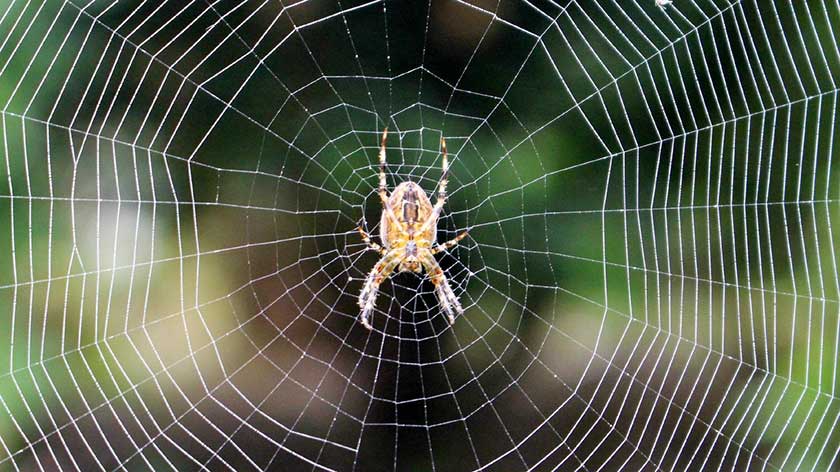
Do you have spiders in or around your home?
Have no fear! We have a lot of experience with spiders and will show you the best ways to get rid of spiders, remove them from your home, and we’ll also show you some of the best spider killers.
Keep in mind that your approach may vary depending on the type of spider and if it’s living inside or outside of your home. Don’t worry though, we will cover all of that below!
These methods include both traditional methods and those which are safe and non-toxic for spider removal. Use the navigation menu below to jump right to the article you are interested in.
Here Are the Best Ways to Get Rid of Spiders
Considerations to Get Rid of Spiders Indoors
There are a number of ways to keep spiders away. Treatments will vary based on the type of spider you are dealing with and the location of the infestation. We find that the best way to get rid of spiders typically involves a comprehensive approach initializing multiple products and strategies. We are going to show you our favorite methods below as well as the best spider killer.
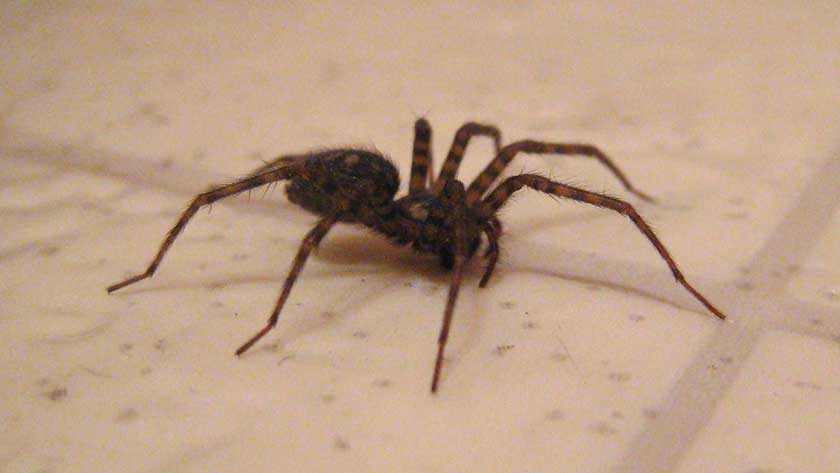
First, be sure to safeguard the exterior of your home before you focus on indoor spider control. Also, some of the same methods outside can be used inside your home, however, it is important to consider the fact that many methods that might be effective outdoors might put you or your family at risk due to exposure to dangerous chemicals. Let’s explore some of the methods available for indoor spider control.
1. Terro 3200ndoor Spider Traps for Your Home
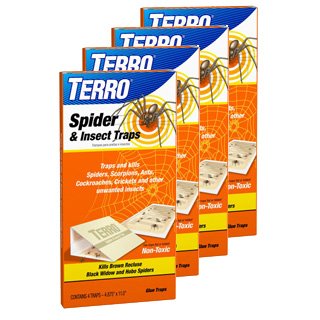
Terro spider traps safe are non-toxic and use a sticky glue to trap spiders. It’s a convenient and easy-to-use spider trap. It even lasts for 3 months and along with trapping spiders, it will also trap all other kinds of insects. Spiders will then go to feed on these insects and get trapped too.
Nowadays a lot of different types of traps and techniques are advertised for getting rid of spiders in your home but the tried-and-true method of a glue trap is one of the best ways to trap spiders. Glue traps are usually flattened sheets with no raised edges and contain some sort of adhesive for trapping spiders. In addition to getting rid of spiders through trapping glue traps are great to figure out which kind of spiders are lurking inside your home in the first place. Since some spiders only come out at night it might be a good idea to get some glue traps if you are trying to figure out which spiders might be hiding out-of-sight. Spider traps will not get rid of spiders permanently. Spider traps are only good for lowering spider populations and catching the occasional spider that happens to be crawling over the trap.
If you buy a spider trap proper placement is essential. Place them in the corners of your home, underneath and behind furniture, along baseboards or anywhere where you have seen or suspect spiders are living. One great thing about spider traps is that they are usually safe and non-toxic. Terro is one of the leading brands that make spider traps.
Protecting the Interior of Your Home from Spiders
The number one method for reducing spiders inside your home is keeping your home clean and tidy. Sweeping and vacuuming regularly is of paramount importance. Leftover crumbs laying on the ground attract other insects which in turn attracts spiders. Likewise, don’t leave food lying around on the counter or dirty dishes in the sink. Again, this will attract other critters which will attract spiders. Clean up clutter or anything that spiders might use as a habitat or a place to hide behind or underneath. Use a handheld duster to get the tops of your ceilings and every corner of your house to clean up any spider webs that might be hiding in plain sight.
2. Eversprout Cobweb Duster For Spiders
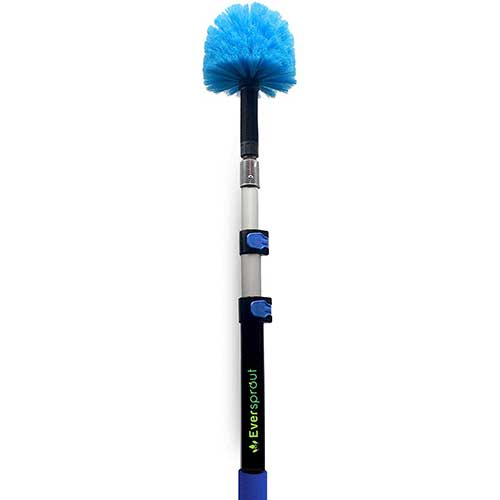
The Eversprout Cobweb Duster and Extension-Pole extends for 5 feet to 13 feet. The duster is great for cleaning those hard-to-reach places where spiders and spider webs are lurking.
Clean out any attics or crawl-spaces you may have and rid them of any dark hiding spots for spiders. Vacuum, dust and get rid of any cobwebs present. It is easiest to use a vacuum that has an extendable handle, hose, or crevice tool to get to heard to reach places. One of the best vacuums available with these features is the Shark Duoclean.
Also, throw out any cardboard or wooden boxes you are using for storage and replace them with plastic. Last but not least, store your kitchen food in air-tight food storage containers. It is much harder for spiders and other pests to enter plastic storage containers with lids. Spraying to Protect Against Spiders in Your Home
3. Wondercide Natural Indoor Pest Control
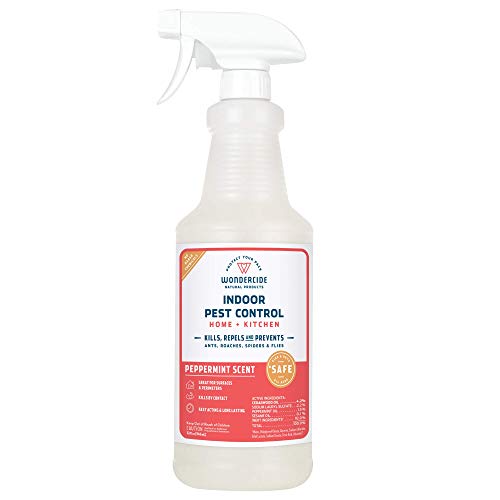
Wondercide Natural Spider Spray comes in four different scents including cedar, lemongrass, peppermint, and rosemary. It is also completely organic, non-toxic, and safe for your pets and family. Organic and homemade sprays are usually less effective than commercial sprays but are much safer for you and your family. Apart from the spray mentioned above you can also use Wondercide Natural Indoor Pest Control Home and Patio Spray.
It both kills and repels insects and spiders and is also made in the U.S.A. Its primary ingredients are cedar oil, sesame oil, and sodium laurel sulfate. These are all ingredients that are extremely safe. Also, depending on which scent you get you also get the benefit of having protection from that oil as well (for example, peppermint oil, which has also been shown to b effective as a repellent). However, unlike the commercial spray above it will only keep spiders away for 2-3 days. It does kill spiders on contact though. This spray can be applied all over the home but you will have to reapply it frequently.
4. Eco-Defense Organic Home Pest Control Spray
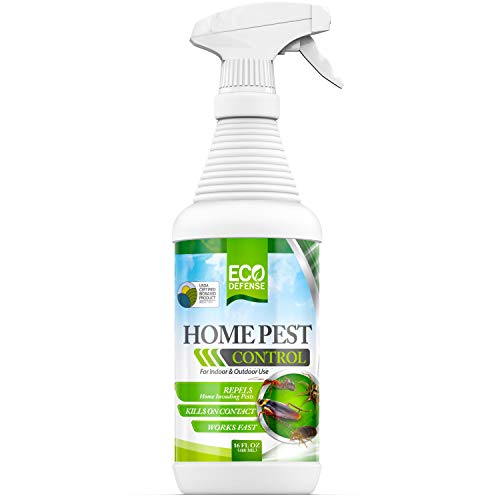
Eco-Defense Organic Home Pest Control Spray One of the top-rated sprays pest control spray and is organic and natural. If you do not want to use the traditional chemicals for exterior spider control for fear of safety or polluting the environment, this is a non-toxic spray that kills bugs on contact.
This spray is made up of sodium laurel sulfate (a common household soap ingredient, used in shampoo since 1930), geranium oil, and peppermint oil. If you still don’t trust a manufactured product to be safe you could also make your own spider spray.
5. Miss Muffet’s Revenge Spider Killer by Wet & Forget
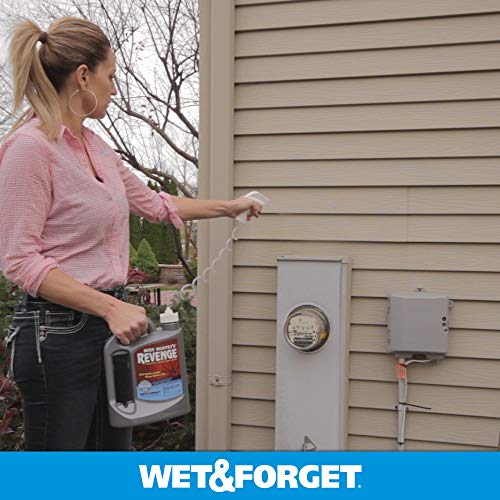
Miss Muffet’s Revenge Spider Killer by Wet & Forget is one of the top commercial sprays with a long residual spider control time. After cleaning up any clutter and vacuuming your home you may want to spray a spider repellant. There are three options available: commercial sprays, organic and non-toxic sprays, or homemade sprays. This a commercial spray for the outside of a home to prevent spiders from living in the area.
You can also use this spray cautiously indoors but realize that it is a chemical base spay and should be in a safe way. Areas that are particular problem areas for spiders also need to be sprayed directly and reapplied if spiders appear again in these areas. You can spray the spray directly on spiders as a spider killer as well. Some areas to consider for application are stairwells, garages, crawl spaces, basements, closets, storage areas, cardboard boxes, underneath staircases, on windows and window seals, ceilings, door frames, and baseboards. Be sure to avoid areas where people and pets frequent. Do not spray near any food or areas where food is served. Also, be sure not to use more than the recommended amount or you may put your family’s health at risk.
6. Onslaught FastCap Spider Insecticide
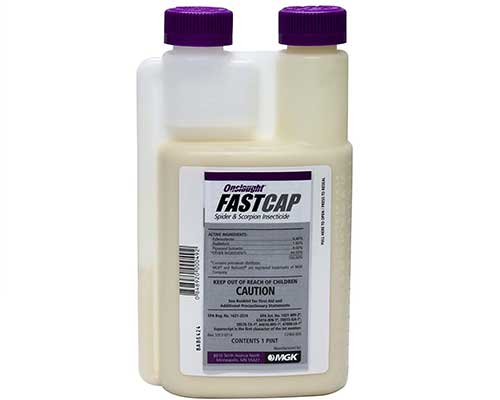
Onslaught FastCap is a popular spider insecticide by MGK. This will kill a large range of bugs including spiders, scorpions, mosquitos, and fleas. It sprays on and is rated to last for 12 months and has a shelf-life of three years. Just mix with water in a common garden sprayer.
Spray the perimeter of the house going up the side of the house about 3 feet and out from the house about 3 feet. Also, spray any areas where there is a lot of clutter or hard-to-reach areas that are dark and look to be good homes for insects and spiders. As a cautionary measure, although this spray is designed as both an indoor and outdoor insecticide, if you are concerned at all about using any hazardous chemicals in your home just use it outdoors only.
7. Homemade Spider Sprays
Homemade sprays primarily consist of essential oils, water or witch hazel, and dish soap. The most common ingredients for homemade sprays are tea tree oil, any citrus oil, neem oil, lavender oil, geranium oil, peppermint oil, citronella oil, cinnamon oil, and clove oil. Add equal drops of essential oil and dish soap (usually 5-6 drops) to a quart of water. Some people prefer to use witch hazel because it dries faster but it’s up to you. Add the mixture to a standard spray bottle and spray the perimeter of your home as well as any potential problem areas where spiders might be lurking.
This spray, like the store-bought organic sprays, need to be constantly reapplied. You can also add these same essential oils to a diffuser if you do not want to reapply every 2-3 days. Some mints can be toxic to dogs and cats so be sure you are using an oil that is safe to use around pets. You can also grow some of the same plants from which the oils are derived indoors using products such as the AeroGarden Harvest home gardening system.
Another good product is the Indoor Harvest Elite, Plant Grow LED Light Kit.
You can also try filling a spray bottle with half water and half vinegar and spraying that around your house as well.
Protecting the Exterior of Your Home from Spiders
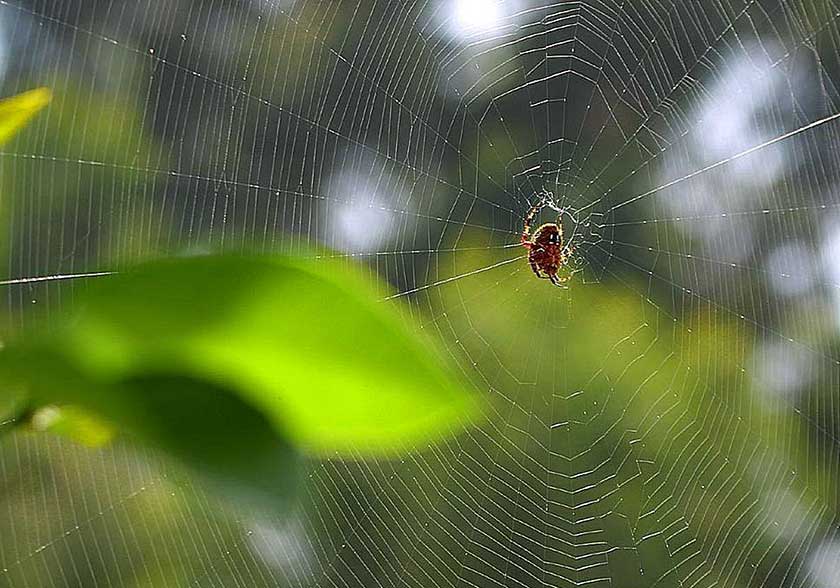
The first area to focus on for getting rid of spiders in your home is the exterior of your house. Wood piles, dense vegetation, excessive storage and clutter in your yard all contribute to the proliferation of spiders in your home. Try to remove, if possible, any dense vegetation close to your home. Also, if you have any areas surrounding your house in need of decluttering, do it as soon as you can. These areas all provide homes for spiders. Although some spiders only lay a few eggs, other spiders can lay up to 3000 eggs so it is important to remove any areas where spiders may be reproducing from around your home.
After removing clutter and any other areas where spiders might reproduce you will want to find a good home defense spray to get rid of the spiders living outside your home.
8. Geranium Essential Oil For Spiders
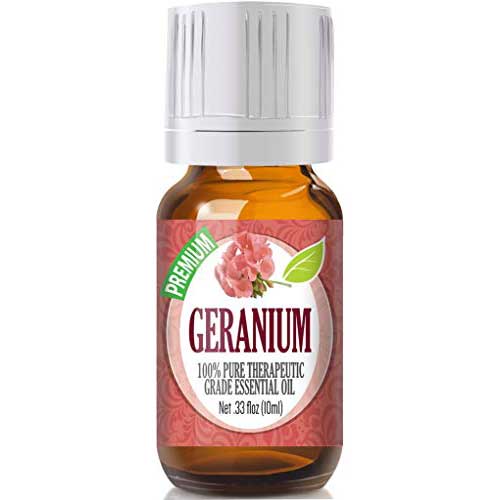
Use the same essential oils above, geranium, and peppermint oil, and then just add your favorite eco-friendly dish soap. Some people also use crushed garlic to get rid of spiders. Just crush 5 cloves of garlic into 2 cups of water and let it sit for 2 hours. Afterward, take the liquid and put it into a common spray bottle.
Or the garden sprayer above for larger applications. Use the same ratio above (only with more garlic and water) for larger volumes. You can also blend a handful of tomato leaves with 1 teaspoon of cornstarch and 2 cups of water. This method, however, would prove more difficult for large applications.
After spraying around your home and all the would-be homes of spiders, next you will want to make sure you seal any cracks or areas for spiders to get inside your home. This is especially important right before the winter months if you live in a cold area when spiders like to come inside the home to keep warm. Check first around doors and windows. If there are any large spaces when the door or windows or closes where spiders could get through, use caulk and seal these gaps. It is recommended to use a weatherproof sealant or caulk such as this top-rated product made by GE.
9. Diatomaceous Earth For Spiders
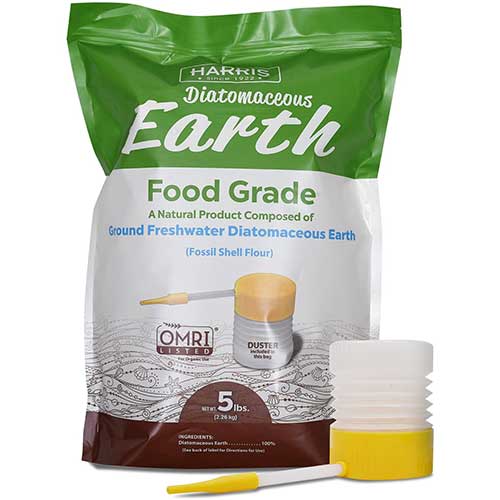
An odd but interesting way to repel spiders and other critters from your home is diatomaceous earth. Diatomaceous earth is made out of fossilized remains from a particular type of algae known as a diatom. The outer shells of diatoms are made out of silica which causes all of the moisture to be sucked out of the pests which might be lurking nearby. You can either sprinkle some in areas where you think spiders might be or along the perimeter of your home. You can also mix one tablespoon with a spray bottle full of water and spray it along the perimeter or your home. The best part is that it is safe, non-toxic, inexpensive, and effective. Another added benefit is that diatomaceous earth has also been found to be effective against bed bugs so you can deter both spiders and bed bugs in one fell swoop.
Related Article: Best Bed Bug Killers
Spiders Around the House
In order to ensure all areas are sealed, also caulk along with any cables, wires or plumbing that runs outside where spiders could crawl along. It is best to caulk every area that looks as if it may be able to be infiltrated by spiders. After caulking all vulnerable exterior areas, cover up any vents or chimneys you may have with wire mesh screens such as this.
Various sizes are available to fit your need. Then replace any broken screens on any of your doors or windows as spiders can get inside any crack that you leave for them.
Another simple way to get rid of other pests is to leave outside lights off whenever possible. Outside lights do no attract spiders directly but do attract other insects that spiders feed on. Installing yellow lights (sodium vapor lights if you can find them) can be a good alternative to keeping your lights off altogether as they tend to attract fewer pests:
Also, install some opaque shades that will not allow light to filter out from the inside and attract pests that spiders will feed off of near your home windows.
Spider and Herbal Plants
One unique and extremely safe solution to help rid your home of spiders is to plant various herbs and plants around your home that repel spiders. Mint is one of the most common plants that is used to repel spiders, ants, and mosquitos. The fact that it eliminates other bugs is also useful in that the less other bugs you have the fewer spiders you will have. Also helpful is planting lavender, citronella, bay leaves, garlic, rosemary, chives and basil around your house.
Although none of these other plants get rid of spiders directly they get rid of other pests that spiders might prey on. You can also put eucalyptus sprigs in and around your other plants as these have also been shown to be helpful in getting rid of spiders and other critters. Also, refrain from using mulch around your house if at all possible. Although some people swear by the use of cedar mulch to get rid of spiders there is little evidence that this works and in fact, cedar mulch is often not true cedar and loses its potency quite rapidly. Instead, put pea gravel around the house as this is not a good home for other insects that spiders might feed on.
Common Spiders You Might Find in Your Home
In the United States, there are estimated to be over 3000 species of spiders, compared to over 43000 species worldwide. Spiders, a type of arachnid, are characterized by eight legs and two body segments. They do not have wings, antennae and are not able to chew at all. Although most people do not realize it, spiders are not insects.
Dangerous Spiders
Also, what might be even more surprising is that most house spiders are completely harmless apart from the brown recluse and hobo spider (black widows usually don’t come into your home unless it’s a dark and damp area such as a garage or basement).
The American House Spider is one of the most common types of spiders that may choose to invade your home and take up residence. It is characterized by its yellow, brown, and tan color, rounded abdomen, and legs with comb-like hairs. The American House Spider is also known for making messy webs that are often found in closets, basements, crawl spaces, and other dark or corner areas of the home. It is harmless but messy. The wolf spider is another common house spider with hairy brown, gray and black color and often looks like a miniature tarantula. It is quicker and larger than most other house spiders.
Related Article: 10 Best Ways to Get Rid of Wold Spiders
Daddy-Longlegs
They are also harmless but in some instances may be harmful to those who suffer from allergies to these spiders. Known as “daddy-longlegs” to most people, the long-bodied cellar spider is another spider you might encounter in your home. They have small brown, beige, or grey bodies with really long legs. They’re most likely to build webs in your crawl space, cellar, basement, garage or any other dark area of your home where you can see them hanging upside-down.
Jumping Spiders
Jumping spiders are another common household pest. These small brown and black spiders are often seen along the wall, screens, near windows or doors, or any other area that is exposed to light. These spiders like the light because they hunt their prey during the day. You can tell them apart from most other spiders by their characteristic erratic jumping movements. Although they do bite people it is no worse than a bee sting unless you have allergies to them
Poisonous Spiders You Might Find in Your Home
The two types of poisonous spiders you may encounter in your home are the brown recluse and hobo spider.
Brown Recluse Spider
The brown recluse comes from a family of spiders known as brown spiders. It is found in sixteen states including Kansas, Oklahoma, Texas, Louisiana, Arkansas, Missouri, Mississippi, Alabama and parts of Georgia, Tennessee, Kentucky, Ohio, Indiana, Illinois, Iowa and Nebraska. This spider generally prefers an area with high humidity. As its name suggests it is brown in color and characterized by a fiddle-like shape on its back. Some people even refer to them as “fiddleback spiders” or “violin spiders.” Another defining characteristic is the fact that they have six eyes, unlike most spiders which have eight. You can also tell a brown recluse spider from other spiders because it has a uniform color. It also has no spines and only fine hairs covering its body.
As a “recluse” it is generally found hiding in areas that are dark and secluded. You won’t see them during the day since they are nocturnal and only hunt prey at night. A few areas you might find them are under dark porches or hidden inside dark places in the home like deep closets, storage areas, attics, garages or inside cardboard boxes. If you are bit by a brown recluse you usually will have no symptoms or only a small red bump with minimal swelling. However, because their venom is so poisonous it can lead to tissue death in the area and then begin to spread within a few days. A brown recluse is the only spider that may cause death through its bite. If you suspect you have brown recluse spiders in your home be sure you take action immediately to get rid of these deadly spiders.
Hobo Spider
The hobo spider is a reddish-brown, or rust-colored, spider that comes from a genus of spiders known as funnel web spiders. They are known are such because they build funnel-shaped webs that are open at both ends with one end expanding into a curved sheet. Hobo Spiders are also called “hobos” due to the fact that they are known to hitch rides with humans and are transferred to different areas. They are mostly found in the Pacific Northwest but are quickly expanding across the United States. They are about a half-inch long with the female being slightly bigger than the male. It has a herringbone pattern, similar to a twill weave, on the top side of its abdomen and hairy-looking legs (although the legs are actually smooth) that are light brown and solid in color (if the legs have stripes it is not a hobo spider).
It can generally be found in your home hiding in cardboard boxes, storage areas, near baseboards or radiators, underneath or behind furniture, dark closets, or woodpile stacks near your fireplace. Sometimes they due end up in tubs or sinks when sinking moisture. For the most part, however, they tend to stay near or on the ground. Although it doesn’t have many distinguishing features, the hobo spider does tend to make rapid, darting movements. A bite from a hobo spider is not as bad as a brown recluse bite and it is not necrotic. That said, the hobo spider’s bite can cause pain and swelling (a large red mark occurs around the bite that eventually reduces to the size of a mosquito bite) as well as headache, nausea, fatigue, and in some cases even temporary visual impairment.
Black Widow Spider
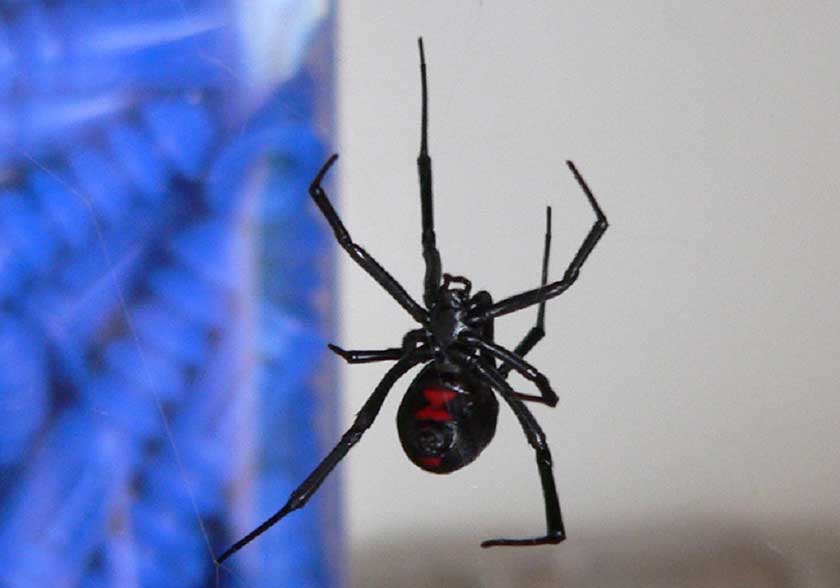
Although some people have found the black widow inside their home the black widow spider is primarily an outdoor spider. Black widow spiders tend to build their nests in dark, dry shelters. However, the way that most people encounter black widows is due to the fact that black widow spiders also build their webs around grape vineyards. People who buy grapes from the grocery store might accidentally bring a black widow spider into their home. Be sure to check carefully when you are purchasing anything from the grocery store to ensure that you are not accidentally bringing a black widow or any other type of spider into your home.
Black widow spiders are shiny black, relatively small (10 millimeters in length) and have a colored (usually red), hourglass shape on their abdomens. They are found mainly in temperate regions in the northeastern part of the United States and as west as Texas and as far south as Florida. They get the name “black widow” because the female actually devours the male after mating. This is also one of the reasons that the female actually has a much longer lifespan than the male.
Black widow spider’s venom
The black widow spider’s venom is 15 times stronger than a rattlesnake but most people who are bitten rarely suffer a fatality. Black widows are not very aggressive and will usually only bite in defense. The bite from a black widow spider usually causes nausea, breathing difficulty, and muscle aches. It will leave a bit of redness around the area of the bite and possibly two small marks from the fangs. Black widows usually leave large webs near ground level which are very dense and irregular in shape. They usually live underneath objects such as logs, firewood, stones and can be found in buildings such as sheds, barns, and garages. You won’t usually find them indoors but if you do they will be inside crawl spaces or in the basement of your home.
Hacks, Tips, and Tricks to Get Rid of Spiders Naturally
There are many other ways to get rid of spiders that most people might not think about. Since you are going to be cleaning your house anyways, try using cleaning products that contain any of the ingredients known to get rid of or repel spiders. Any citrus-based cleaner should work well as well as any that contain any of the essential oils mentioned above.
You can even use lemon or orange-scented furniture polish to polish your furniture. Try also burning candles that contain citronella or any other scent that deters spiders, such as peppermint, rosemary or cedar. People also put horse chestnuts around their homes to get rid of spiders. If you try this be sure not to put any chestnuts around where small children might put them in their mouths since they are poisonous.
Many people put them in the corners of their rooms or on the top of windowsills but you can put them wherever. Likewise, you can also do the same thing with garlic cloves as it is said that garlic cloves will also scare away spiders. Put these in the same spots that you would put the chestnuts. Also, you can do the same with cinnamon sticks as these have been found to get rid of spiders as well. If you’re not allergic, get an animal. Cats, for instance, loves to hunt little critters such as spiders and you get the added benefit of having a wonderful companion.
When Should I Call a Service to Remove Spiders from My Home?
With so many options available to deter and rid your home of spiders only call a pest control service if you are overwhelmed and unable to control your spider problem through all other available means. It is also extremely expensive to call a service and might be overkill for your particular situation. A pest control service can charge anywhere from $300 to $500 which is not cheap.
That said, most pest control and spider control services will actually come out and do a free appraisal of your particular situation. You might want to call them out just to make sure you do not have a serious problem if you are truly concerned. Take what they say with a grain of salt though as they might just be trying to get you to use their service. However, in the process of consulting with a pest control service company about your spider problem you may learn some valuable pieces of advice which could help you control the problem on your own and in the future.
My name is Blane and I’m a life-long resident of Southeastern Louisiana. I’ve been working as Pest Control Technician and Inspector for about 1.5 years now.
I’ve worked in many other industries as well, including consulting, managing, as well as at the ground level in fields including Food Service, Corporate Automotive sales, and finance. Whether it be providing counsel, content, or hands-on support; my goal remains to add value to the lives of the people I serve.
If you have any questions regarding pest control, leave them below. I would be happy to help you out in any way I can.


Hello!
Reading your article about spiders, and the varying products to prevent and kill them has been educational. That said, I wanted to mention a couple of things.
One, the spiders shown in photos above with the “orb” web, are Orb Weavers. There are many different species, however, your article leads readers to believe they come into homes. They truly do not. Even in winter, I have yet to find one indoors. They’re found only in the middle of these beautiful, complex webs on bushes, in between and on trees, etc. I do not care for spiders necessarily, but these are very interesting along with beneficial. I have grown to respect them.
Two, a spider that I do NOT respect are the Widows. Until I moved to Northern CA, I did not know that BROWN Widows are alive and well too! This was not mentioned in your article. They’re smaller than the black and inject more poison than the black! They have either a yellow or orange hourglass on the abdomen.
Third, and last, CA DOES have Fiddlebacks aka Brown Recluse! I live in the middle of cattle fields and have all mentioned species of spiders!
Thank you for reading and thank you for the information in the article.